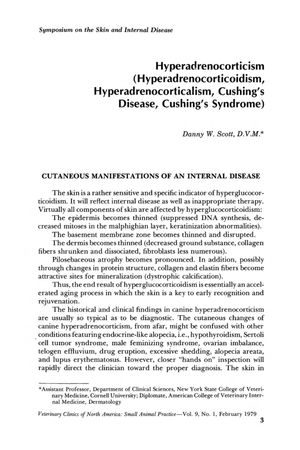Hyperadrenocorticism (Hyperadrenocorticoidism, Hyperadrenocorticalism, Cushing’s Disease, Cushing’s Syndrome)
February 1979
in “Veterinary Clinics of North America: Small Animal Practice”

TLDR Treatment can improve survival and symptoms in dogs with Cushing's disease, but outcomes are unpredictable.
The 1979 document outlines the treatment approaches and prognosis for dogs with hyperadrenocorticism, also known as Cushing's disease or syndrome. It describes the use of unilateral adrenalectomy for adrenocortical neoplasms, bilateral adrenalectomy for bilateral adrenocortical hyperplasia, and medical therapy with O,P'-DDD (Lysodren) for bilateral hyperplasia. The document notes that 9 out of 23 dogs treated with O,P'-DDD were still alive over a three-year period. For iatrogenic hyperadrenocorticism, the cessation of glucocorticoids and administration of hydrocortisone were recommended, with remission typically occurring within 4 to 12 weeks. The prognosis for untreated cases is poor, with death within 6 to 24 months, but therapy can improve outcomes, although it remains unpredictable. Successful therapy can lead to symptom regression and hair regrowth within 4 to 12 weeks, with hair color often returning to normal in the subsequent hair cycle.
View this study on sciencedirect.com →